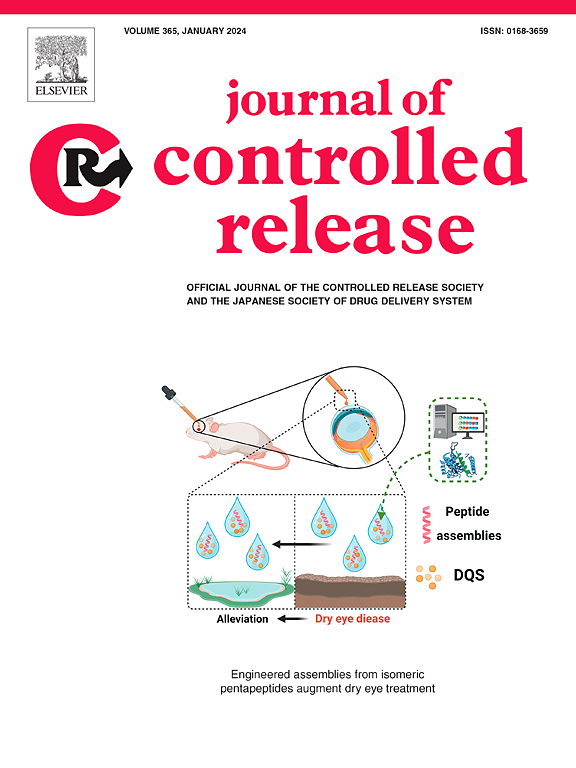靶向脂质纳米颗粒治疗肥胖的siRNA和mRNA组合方法
IF 10.5
1区 医学
Q1 CHEMISTRY, MULTIDISCIPLINARY
引用次数: 0
摘要
肥胖是一个影响数百万人的普遍的全球健康问题,其特点是脂肪过量沉积和代谢功能障碍,大大增加了2型糖尿病、心血管疾病和某些癌症等合并症的风险,所有这些都导致可预防的发病率和死亡率上升。目前治疗肥胖的方法,包括改变生活方式和药物治疗,往往面临一些局限性,如长期依从性差、副作用,以及对疾病背后复杂的多因素途径的靶向性不足。在此,我们报告了一种双重rna介导的组合方法,使用靶向脂质纳米颗粒(LNP)治疗肥胖。LNPs与编码白细胞介素-27 (mIL-27)的mRNA共包被,共激活PGC-1α、PPARα和UCP-1,从而促进脂肪细胞分化,增强脂肪细胞内的适应性产热;LNPs与靶向二肽基肽酶-4 (siDPP-4)的siRNA共包被,沉默胰促胰岛素系统内GLP-1的一级抑制酶和GIP,有效恢复葡萄糖稳态。在饮食诱导肥胖(DIO)小鼠模型中,翻译后DPP-4沉默和IL-27上调后,在分子、蛋白质和组织水平上观察到产热生物标志物PGC-1α、PPARα和UCP-1的表达增加,胰岛素敏感性恢复。重要的是,这种基因调节导致DIO模型治疗后体重减少21.1% %。这些发现首次证明了一种双rna介导的组合方法,利用肝脏靶向LNP递送,通过肠促胰岛素系统调节和诱导脂肪细胞分化和产热,在siDPP-4和mIL-27共同递送后发挥协同作用。这一创新策略为解决肥胖及其相关代谢功能障碍提供了一个有希望的替代框架。本文章由计算机程序翻译,如有差异,请以英文原文为准。

A combinatorial siRNA and mRNA approach for obesity treatment using targeting lipid nanoparticles
Obesity, a widespread global health issue affecting millions, is characterized by excess fat deposition and metabolic dysfunction, significantly elevating the risk of comorbidities like type 2 diabetes, cardiovascular disease, and certain cancers, all of which contribute to rising rates of preventable morbidity and mortality. Current approaches to obesity, including lifestyle modifications, and pharmacotherapy, often face limitations such as poor long-term adherence, side effects, and insufficient targeting of the complex, multifactorial pathways underlying the disease. Herein we report a dual, RNA-mediated combinatorial approach using targeting lipid nanoparticles (LNP) for the treatment of obesity. LNPs were co-encapsulated with mRNA encoding Interleukin-27 (mIL-27) to coactivate PGC-1α, PPARα, and UCP-1, thereby promoting adipocyte differentiation and enhancing adaptive thermogenesis within adipocytes, and siRNA targeting Dipeptidyl peptidase-4 (siDPP-4) to silence the primary inhibitory enzyme of GLP-1, and GIP within the incretin system, effectively restoring glucose homeostasis. Following post translational silencing of DPP-4 and upregulation of IL-27 in a diet-induced obesity (DIO) mice model, increased expression of thermogenic biomarkers PGC-1α, PPARα, and UCP-1 was observed at the molecular, protein, and tissue level, and insulin sensitivity was restored. Importantly, this gene modulation led to a 21.1 % reduction of bodyweight after treatment in the DIO model. These findings demonstrate for the first time a dual RNA-mediated combinatorial approach, leveraging liver targeting LNP delivery with synergistic effects from incretin system regulation and induction of adipocyte differentiation and thermogenesis after codelivery of siDPP-4 and mIL-27. This innovative strategy provides a promising alternate framework for addressing obesity and its associated metabolic dysfunction.
求助全文
通过发布文献求助,成功后即可免费获取论文全文。
去求助
来源期刊

Journal of Controlled Release
医学-化学综合
CiteScore
18.50
自引率
5.60%
发文量
700
审稿时长
39 days
期刊介绍:
The Journal of Controlled Release (JCR) proudly serves as the Official Journal of the Controlled Release Society and the Japan Society of Drug Delivery System.
Dedicated to the broad field of delivery science and technology, JCR publishes high-quality research articles covering drug delivery systems and all facets of formulations. This includes the physicochemical and biological properties of drugs, design and characterization of dosage forms, release mechanisms, in vivo testing, and formulation research and development across pharmaceutical, diagnostic, agricultural, environmental, cosmetic, and food industries.
Priority is given to manuscripts that contribute to the fundamental understanding of principles or demonstrate the advantages of novel technologies in terms of safety and efficacy over current clinical standards. JCR strives to be a leading platform for advancements in delivery science and technology.
 求助内容:
求助内容: 应助结果提醒方式:
应助结果提醒方式:


